

Moringa oleifera. "Drumstick tree" and variants thereof redirect here.

This name is also used for the golden shower tree (Cassia fistulosa) Moringa oleifera is the most widely cultivated species of the genus Moringa, which is the only genus in the family Moringaceae. Acacia mearnsii. Acacia mearnsii is a fast-growing, extremely invasive leguminous tree native to Australia.

Common names for it include black wattle, Acácia-negra (Portuguese), Australian acacia, Australische Akazie (German), Swartwattel (Afrikaans), Uwatela (Zulu). This plant is now known as one of the worst invasive species in the world.[2] Taxonomy[edit] Émile Auguste Joseph De Wildeman described the black wattle in 1925.[3] The species is named after American naturalist Edgar Alexander Mearns, who collected the type from a cultivated specimen in East Africa.[4] Acacia pycnantha. Acacia pycnantha (Golden Wattle) is Australia's floral emblem.
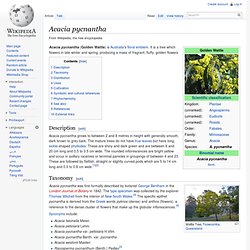
It is a tree which flowers in late winter and spring, producing a mass of fragrant, fluffy, golden flowers. Description[edit] Acacia pycnantha grows to between 2 and 8 metres in height with generally smooth, dark brown to grey bark. The mature trees do not have true leaves but have long, sickle-shaped phyllodes. These are shiny and dark green and are between 8 and 20 cm long and 0.5 to 3.5 cm wide. Taxonomy[edit] Acacia falcinella Meisn.Acacia petiolaris Lehm.Acacia pycnantha var. petiolaris H.Vilm.Acacia pycnantha Benth. var. pycnanthaAcacia westonii MaidenRacosperma pycnanthum (Benth.) Acacia decurrens. Acacia decurrens (acacia bark, early black wattle, green wattle, Sydney wattle, wattle bark, tan wattle, golden teak, or Brazilian teak) is a perennial tree or shrub native to eastern New South Wales, including Sydney, the Greater Blue Mountains Area, the Hunter Region, and south west to the Australian Capital Territory.
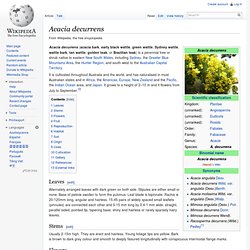
It is cultivated throughout Australia and the world, and has naturalised in most Australian states and in Africa, the Americas, Europe, New Zealand and the Pacific, the Indian Ocean area, and Japan. It grows to a height of 2–10 m and it flowers from July to September.[2] Leaves[edit] Alternately arranged leaves with dark green on both side. Stipules are either small or none. Acacia dealbata. Acacia dealbata (known as silver wattle, blue wattle[3] or mimosa[4]) is a species of Acacia, native to southeastern Australia in New South Wales, Victoria, Tasmania, and the Australian Capital Territory and widely introduced in Mediterranean, warm temperate, and highland tropical landscapes.[5][6] Description[edit] It is a fast growing evergreen tree or shrub growing up to 30 m tall, typically a pioneer species after fire.

The leaves are bipinnate, glaucous blue-green to silvery grey, 1–12 cm (occasionally to 17 cm) long and 1–11 cm broad, with 6–30 pairs of pinnae, each pinna divided into 10–68 pairs of leaflets; the leaflets are 0.7–6 mm long and 0.4–1 mm broad. The flowers are produced in large racemose inflorescences made up of numerous smaller globose bright yellow flowerheads of 13–42 individual flowers. Subspecies[edit] There are two subspecies:[5] A. dealbata dealbata. Some authorities consider A. dealbata to be a variant of Acacia decurrens.[3] Cultivation and uses[edit]
Acacia nilotica - liver/spleen/impotence/leprocydiarreah. Tannin - kidney. Tannin powder (mixture of compounds).
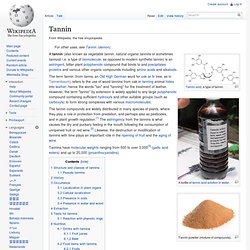
Tannins have molecular weights ranging from 500 to over 3,000[3] (gallic acid esters) and up to 20,000 (proanthocyanidins). Structure and classes of tannins[edit] There are three major classes of tannins:[4] Shown below are the base unit or monomer of the tannin. Particularly in the flavone-derived tannins, the base shown must be (additionally) heavily hydroxylated and polymerized in order to give the high molecular weight polyphenol motif that characterizes tannins. Typically, tannin molecules require at least 12 hydroxyl groups and at least five phenyl groups to function as protein binders.
Pseudo tannins[edit] Pseudo tannins are low molecular weight compounds associated with other compounds. Myracrodruon urundeuva- neuroprotective. Myracrodruon urundeuva (Portuguese common names: aroeira-do-sertão, urundeúva, aroeira preta, urindeúva, arindeúva; syn. Astronium urundeuva (Fr. & All.) Engl., Astronium juglandifolium Griseb.) is a timber tree, which is often used for beekeeping. Catechu. Catechin - neuroprotective:dark chocolate. Catechin /ˈkætɨtʃɪn/ is a flavan-3-ol, a type of natural phenol and antioxidant.

It is a plant secondary metabolite. It belongs to the group of flavan-3-ols (or simply flavanols), part of the chemical family of flavonoids. The name of the catechin chemical family derives from catechu, which is the tannic juice or boiled extract of Mimosa catechu (Acacia catechu L.f)[1] Chemistry[edit] Catechin numbered The most common catechin isomer is the (+)-catechin.
The different epimers can be distinguished using chiral column chromatography.[2] Making reference to no particular isomer, the molecule can just be called catechin. Diastereoisomers gallery 3D view of "pseudoequatorial" (E) conformation of(+)-catechin Moreover, the flexibility of the C-ring allows for two conformation isomers, putting the B ring either in a pseudoequatorial position (E conformer) or in a pseudoaxial position (A conformer). Catechol. Catechol, also known as pyrocatechol or 1,2-dihydroxybenzene, is an organic compound with the molecular formula C6H4(OH)2.
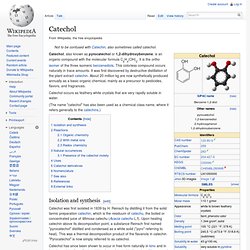
It is the ortho isomer of the three isomeric benzenediols. This colorless compound occurs naturally in trace amounts. It was first discovered by destructive distillation of the plant extract catechin. About 20 million kg are now synthetically produced annually as a basic organic chemical, mainly as a precursor to pesticides, flavors, and fragrances. Acacia. Acacia (/əˈkeɪʃə/ or /əˈkeɪsiə/), known commonly as acacia, thorntree, whistling thorn, or wattle, is a genus of shrubs and trees belonging to the subfamily Mimosoideae of the family Fabaceae, described by the Swedish botanist Carl Linnaeus in 1773 based on the African species Acacia nilotica.
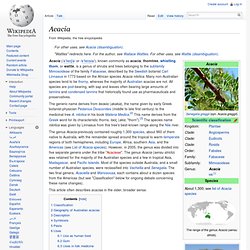
Many non-Australian species tend to be thorny, whereas the majority of Australian acacias are not. All species are pod-bearing, with sap and leaves often bearing large amounts of tannins and condensed tannins that historically found use as pharmaceuticals and preservatives. The generic name derives from ἀκακία (akakia), the name given by early Greek botanist-physician Pedanius Dioscorides (middle to late first century) to the medicinal tree A. nilotica in his book Materia Medica.[2] This name derives from the Greek word for its characteristic thorns, ἀκίς (akis; "thorn").[3] The species name nilotica was given by Linnaeus from this tree's best-known range along the Nile river.
Classification[edit]